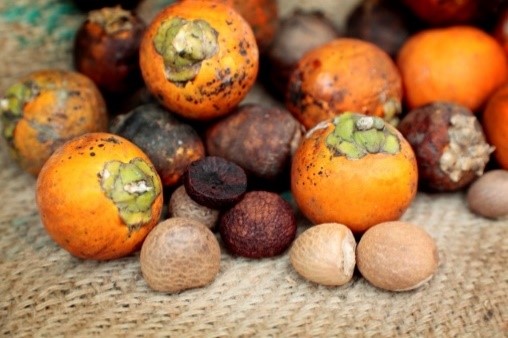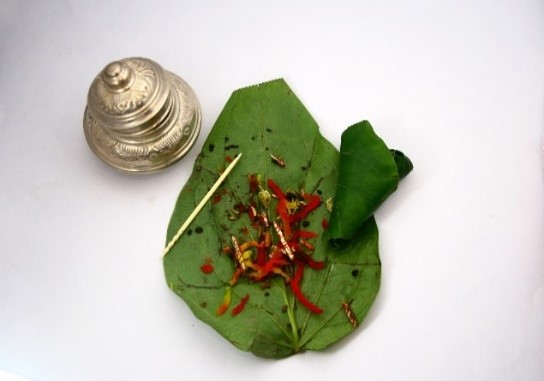What are betel nut products and preparations?
Betel nut is the seed of the fruit of the areca palm. It is also known as areca nut.
The product or preparation depends on the customs in the country of origin. For example, betel nut products and preparations can be known as 'paan' or 'supari' (India and Pakistan), 'bin lang' (China), 'puwak' (Sri Lanka) and 'buai' or 'daka' (Papua New Guinea)2,3.
How prevalent is betel nut use?
Around 10% of the world’s population (600 million people) chew betel nut in some form2. Betel nut is the 4th most widely used psychoactive substance in the world, after nicotine, alcohol and caffeine4 .
Betel nut plays an important role in social customs, religious practices and cultural rituals in the Asia-Pacific region1,2. Betel nut use is common in India, Sri Lanka, Maldives, Bangladesh, Myanmar, Taiwan and several islands in the South Pacific region, including Papua New Guinea. Betel nut is also used in Thailand, Indonesia, Malaysia, Cambodia, Vietnam, Philippines, Laos, China and in the migrant communities from these countries2.
 Figure 1 - Areca nut is the seed of the areca palm (areca catechu), which grows in most of the tropical Pacific and Asia. It is commonly known as betel nut, as it is often chewed wrapped in betel leaves.
Figure 1 - Areca nut is the seed of the areca palm (areca catechu), which grows in most of the tropical Pacific and Asia. It is commonly known as betel nut, as it is often chewed wrapped in betel leaves.
In Australia, betel nut is mostly used amongst those born in the Indian subcontinent and South-East Asia, including refugees.
Betel nut is used for ceremonial and recreational reasons3,5, including social and cultural inclusiveness, improved mood, alertness, as a digestive aid after meals, mouth freshener, as well as for it's pleasant smell and taste6.
How is betel nut used?
Betel nut can be used on its own or as a mixture of various ingredients, known as 'betel quid'. In its most basic form, betel quid consists of betel leaf, betel nut, slaked lime (calcium hydroxide), various spices and is often mixed with tobacco2.
Betel quid may be self-prepared with the ingredients wrapped in the betel leaf, or commercially made with the powdered ingredients packaged in tins or sachets2,7. The quid is placed in the mouth (usually between the gum and cheek) and may be chewed, or remain in contact with the oral mucosa8.
 Figure 2 - Paan - a preparation of betel leaf with betel nut and/or cured tobacco. It is used in Hindu rituals.
Figure 2 - Paan - a preparation of betel leaf with betel nut and/or cured tobacco. It is used in Hindu rituals.
Why is it a concern in NSW?
Betel nut has been declared as a group 1 carcinogen to humans8. The active ingredient in betel nut, arecoline, is a Schedule 4 poison9. The number of people presenting with health issues associated with betel nut use is increasing in Australia10.
People migrating from countries where betel nut is traditionally used will often continue this practice10. A high proportion of people migrating to NSW are from countries where the practice is common, including India, China, Philippines, Vietnam, Nepal and Pakistan11.
People who use betel nut products and preparations may be unaware of their harmful effects.5
What are the health issues associated with betel nut use?
Use of betel nut products and preparations are linked with a range of short- and long-term health issues.
Use of betel nut is known to cause:
- increase in heart rate, blood pressure, sweating and body temperature1
- feelings of well-being and alertness1
- discoloured teeth and gums1
- mouth ulcers and gum disease1
- dependence on betel nut1
- oral precancerous lesions, including erythroplakia and leukoplakia8
- oral submucous fibrosis1
- oral cancers (predominantly of the lip, mouth, tongue, and pharynx)1,12
- peptic ulcer1
- cardiovascular effects8
- increased risk of having a low birth-weight infant7.
How do I conduct a brief intervention?
Health professionals can conduct brief interventions with patients who use betel nut. It is recommended that health professionals advise patients:
- of the harms of betel nut use
- to avoid chewing betel quid late at night because it is a stimulant8
- to avoid using alcohol, tobacco or other drugs during or after chewing betel quid, due to the associated health risks.
If the patient also uses tobacco products, it is recommended they are referred to
Quitline.
For dental practitioners, it is also recommended that they screen for signs or symptoms of oral cancer and provide brief advice to patients who use betel nut.
Acknowledgements
This resource was collaboratively developed with: Australian Centre for Integration of Oral Health (ACIOH); Dental Health Services Victoria; Illawarra Shoalhaven LHD; La Trobe University; Northern Sydney LHD; University of Melbourne; University of Sydney; Western Sydney LHD; Western Sydney University; South Western Sydney LHD.
References
- Australian Drug Foundation, 2020,
Betel Nut, accessed January 2021.
- Gupta PC, Warnakulasuriya S, 2002, Global epidemiology of areca nut usage, Addiction Biology, Areca Nut Symposium, vol 7, pp, 77-83.
- Cox SC, 2008, Studies in areca nut use and its possible role in oral pre‐malignancy and oral submucous fibrosis, Sydney: The University of Sydney, January, PhD thesis.
- Gupta PC, Ray CS, 2004, Epidemiology of Betel Quid usage, Annals Academy of Medicine, July, vol 33 (Supp1), No4.
- Furber S, Jackson J, Johnson K, Sukara R, Franco L, 2013, A qualitative study on tobacco smoking and betel quid use among Burmese refugees in Australia, Journal of Immigrant and Minority Health, vol 15, No6, pp. 1133-1136.
- Banerjee SC, Ostroff JS, Bari S, D'Agostino TA, Khera M, Acharya S, et al., 2014,
Gutka and Tambaku paan use among South Asian immigrants: a focus group study, Journal of Immigrant and Minority Health, June, vol 16, pp. 531–539.
- Sukumar S, Coleman HG, Cox SC, 2012, Areca nut chewing in an expatriate population in Sydney: report of two cases, Australian Dental Journal, vol 57, No3, pp. 373-378.
- International Agency for Research on Cancer (IARC), 2004, Betel quid and areca nut chewing and some areca nut derived nitrosamines, IARC Monograph evaluation Carcinogenic Risks to Humans, vol 85, pp. 1-334.
- Australian Government, 2015,
Australia New Zealand Food Standards Code – Schedule 23 – Prohibited plants and fungi, Federal Register of legislation, accessed January 2021.
- Australian Broadcasting Corporation (ABC), 2020,
Betel nut black market boom in Australia has experts warning of devastating health impacts, accessed December 2020.
- Department of Home Affairs,
2020, 2019 – 20 Migration Program Report, accessed December 2020.
- Chen P-H, Mahmood Q, Mariottini GL, Chiang TA, Lee KW, 2017, Adverse Health Effects of Betel Quid and the Risk of Oral and Pharyngeal Cancers, BioMed Research International, December, accessed December 2020.
- Saraswat N, Pillay R, Everett B, George A, 2020,
Knowledge, attitudes and practices of South Asian immigrants in developed countries regarding oral cancer: an integrative review, BMC Cancer, May, vol 20, No477, accessed December 2020.
- Joo YJ, Moadsiri A, Newcombe D, Nosa V, Bullen C, 2020,
E-learning: A Tool to Upgrade the Skills of Health Workers to Address Betel Quid and Areca Nut Chewing, Substance Use & Misuse, vol 55, No9, pp. 1525-1527, accessed December 2020.
